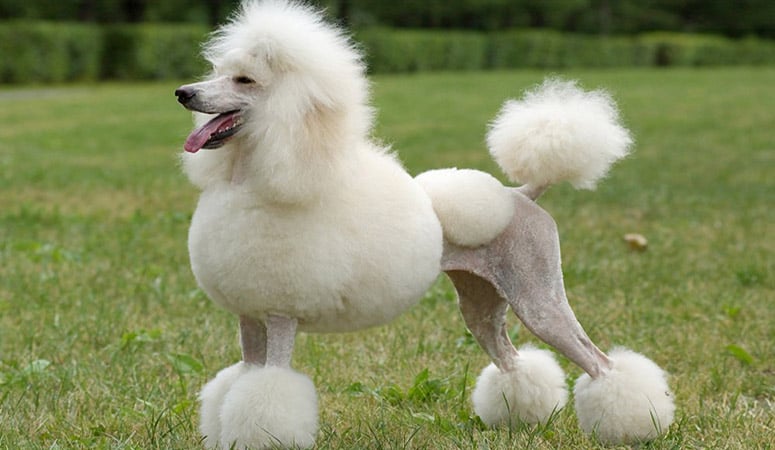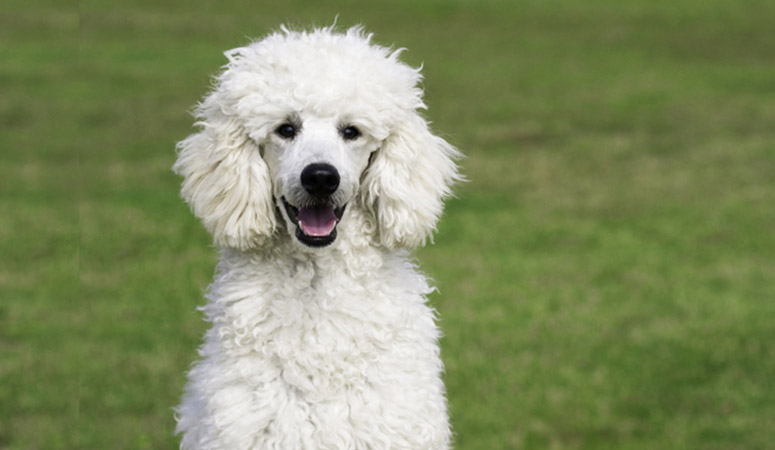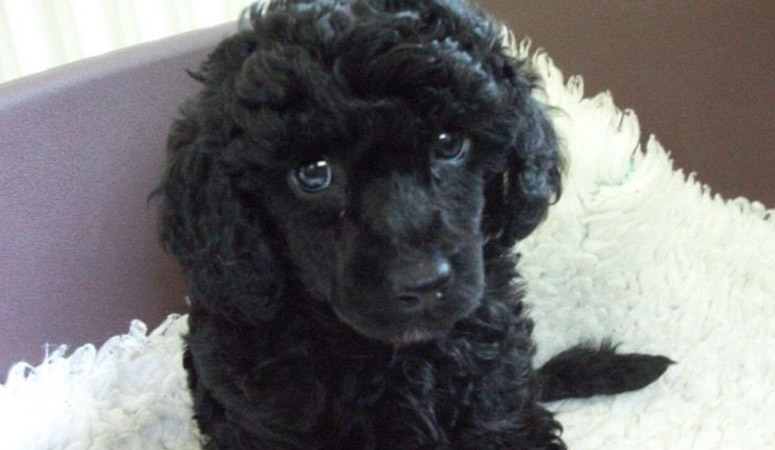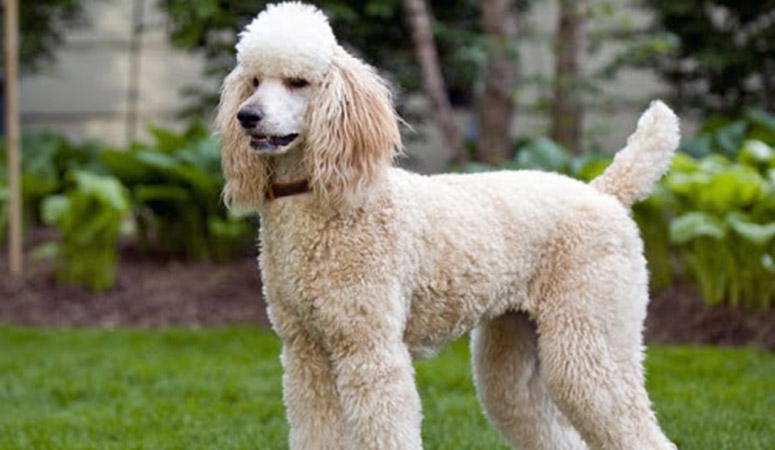Poodle (Standard)
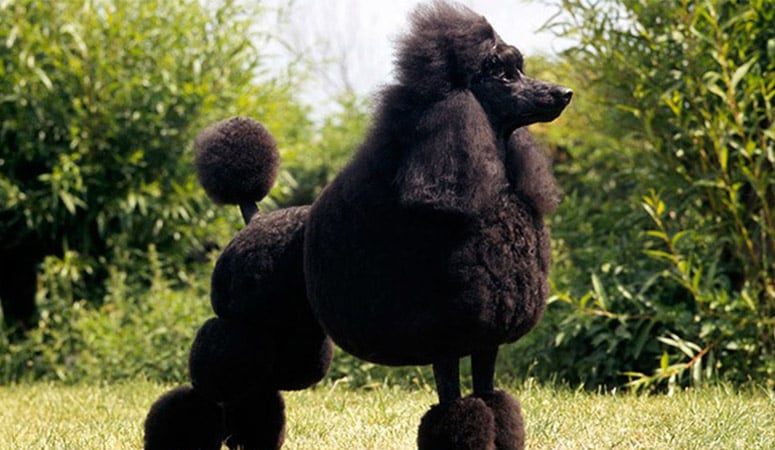
With a minimum 15 inches tall at the shoulder, standard poodles are well-proportioned dogs characterized by dolichocephalic skulls, flat cheekbone, oval or almond-shaped eyes, elegant necks, close-hanging ears, athletic bodies, docked tails, and compact feet with well-arches toes. As one of the aristocrats of dogdom, this dog breed is graceful, active, intelligent, noble, and good-natured.
| Other Names | Caniche, Pudel |
| Color | White, Black, Brown, Blue, Gray, Silver, Cafe au lait, Silver beige, Cream, Apricot, and Red |
| Height | Males: 17-25 inches. Females: 15-24 inches. |
| Weight | Males: 45-70 pounds. Females: 45-70 pounds. |
| Life Span | 10-18 years |
| Personality | Keen, Engaging, Good-natured |
| Exercise | Regular Exercise |
| Origin |
| Popularity | #6 |
| Groom Needs | Professional grooming |
| Kids Friendly | Yes |
| Dog Friendly | Yes with supervision |
| Watch Dog | |
| Family Dog | |
| Litter Size | 2–12 |
Poodle (Standard) Pictures
Poodle (Standard) Video
Introduction
Standard poodles are good at socializing and could get along well with kids and other dog breeds. Being a hypoallergenic dog breed, standard poodles rarely shed and it is the perfect choice for people with allergies. Today’s Poodles seem to really enjoy a good life of luxury and leisure; who doesn’t love their frolicking ways? The three varieties, standard, miniature, and toy, all range from just under 15 inches to no more than 10 inches at the shoulder. The standard-sized poodle is probably the oldest. And they have coats of many colors! Everybody adores them for their eagerness, smartness, athletic and intelligent ways; well, they are ranked just second behind the Border Collie in intelligence. Poodles used to be bred to do real jobs like jumping into the water to fetch waterfowl for hunters. In Germany where they originate, they are called pudel or pudelin and in France, they are called Caniche – it means ‘duck dog’ or puddle in English, or ‘to splash about’. Poodles love people and get lonely when they are not with their family; always looking out to participate in games, sports, and activities.
Living with Poodle (Standard)
Different from other dogs, standard poodles have a dense single-layer coat with a naturally curly texture that could easily result in tangled hairs. For that reason, standard poodles belong to one of the high-maintenance dog breeds and require daily brushing to keep their coats from matting. According to the American Kennel Club, the suggested grooming frequency for standard poodles is every four to six weeks and pet owners could choose either to clip or trim their dogs themselves or to take them for professional dog grooming.
There are many grooming styles for standard poodles including continental clip, English saddle clip, puppy clip, lamb clip, teddy bear clip, bikini clip, and kennel clip. However, American Kennel Club (AKC) only accepts “Continental Clip” or “English Saddle Clip” for adult poodles and “Puppy Clip” for poodles aged under 12 months old. Continental clip is quite similar to the English saddle clip except for the fully shaved hindquarters and legs.
Poodles are very active and high-energy dogs that need regular exercise to release energy and keep healthy. Proper exercise on a regular basis could even extend poodles’ life span. However, exercise frequency and amounts depend on the poodles’ age and health status. For standard poodles under 18 months old, owners must be extremely careful with exercise times. Over-exercise could injure puppies’ soft bone tissue and affect normal bone growth. For standard poodles between 2 years old to 7 years old, it is recommended to have up to 1 hour of exercise per day, which could be split to 2 to 3 smaller chunks. For senior poodles, regular light exercise is still needed to keep them from joint discomfort and maintain as much muscle mass as possible. Poodle owners could choose some easy daily walks or some low-impact exercises like swimming.
Before bringing your poodle home, it is important to ask the breeder or veterinarian to share the information on the food brand and serving size. A sudden change in food brand could increase the risk of upset stomach and digestive problems. Always remember to switch foods by gradually adding the new food to the current food. To transition, you could mix ¼ new food with ¾ old food in the first week, and mix ½ new food with ½ old food in the second week. Patiently follow the 4-week transition schedule, a complete switch to new food could be done in the fourth week. Regarding the exact serving size, it is recommended to follow feeding instructions on the kibble package. Different types of dog food contain different calories and there is no certain standard. Normally, a healthy poodle puppy should be fed approximately 40-55 calories per pound of body weight per day and the adult counterpart needs 35 – 45 calories per pound of body weight per day. However, do not stick to the rules and you should always take your dog’s activity level, health status, and individual metabolism into considerations.
Epilepsy, hip dysplasia, thyroid issue, bloat, and Addison’s diseases are the most common health problems that standard poodles may encounter. Immediate and adequate actions should be taken if owners notice the early signs in their poodles. For instance, dog bloat, also known as gastric dilatation and volvulus (GDV), is an incredibly painful disorder that happened when gas gets the stomach rotated or twisted. With a 20% mortality rate, bloat is a top killer of standard poodles and owners should learn to recognize the symptoms such as sudden apparent distress, restlessness, unproductive vomiting, excessive drooling, pacing, panting, etc. Keep an eye out for these warning signs could lower the risk of developing serious problems and ensure an early treatment before it is too late.
Total Annual Cost: $3210
Cost is estimated for the first year and may vary depending on many factors, such as dog food, health care, leash, collar, licensing, possible fencing, crates, training and obedience classes, dog-walking, grooming, treats, toys, flea, tick, and heart-worm meds, microchips, etc.
Poodles are incredibly energetic and intelligent dogs that could be easily trained. In fact, proper training is essential for poodles’ health and could make them less susceptible to anxiety. Crate training, house training, obedience training, and leash training are the four aspects that you could consider when comes to standard poodle training. To start with, it is strongly suggested to focus on crate training. Introduce your poodle to the crate and feed the dog meals inside the crate. Keep in mind that the crate should be always linked with something pleasant and do not use the crate as a punishment or force your dog into the crate, otherwise your dog will feel feared and frustrated to enter in the future. Crate training might need a few weeks. Take it slowly and continue practicing with longer crating periods after your poodle get used to it.
History
- This cute breed originated in Germany, but also developed into a distinct breed in France.
- Many people say the poodle resulted from being crossed between a few European water dogs – other historians say the poodle’s ancestors are the North African Barbet, a dog which was imported to the Iberian Peninsula. There are many theories, but whatever the case, the poodle is an ancient breed. There are illustrations of dogs looking like poodles that adorn the Roman and Egyptian artifacts and tombs from BC days.
- Goya, the famed Spanish painter; loved to paint poodles, much-pampered favorites during the reign of King Louis XVI.
- The English Kennel Club registered their first poodle back in 1874, and the US American Kennel Club registered their first poodle in 1885.
- From 1950, the poodle had become the most popular breed, holding this status for over 20 years. Today they are ranked sixth with the American Kennel Club.
- What about that special clipped look that poodles often sport? Apparently it was created by hunters to make it easier for the dogs to navigate through the water. The hair that was not cut protected their vital organs and joints whist in the cold water. Others say it stems from their performing days in circuses.
Crawley, a showman, and trainer had a troop of poodles called ‘The Ball of Little Dogs’ that performed before Queen Anne, delighting her no end. They danced and pranced, showing amazing training by keeping in time with the music which accompanied them. What an amazing dog, the Poodle!
Helpful Information
Breed Club: POODLE CLUB OF AMERICA, INC.
Breed Club Link: https://poodleclubofamerica.org/
Breed Club Rescue: POODLE CLUB OF AMERICA RESCUE FOUNDATION, INC.
Breed Club Rescue Link: http://www.poodleclubofamericarescuefoundationinc.org/

